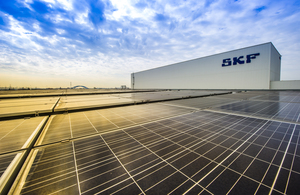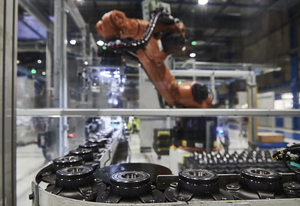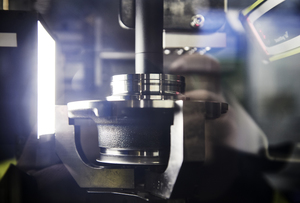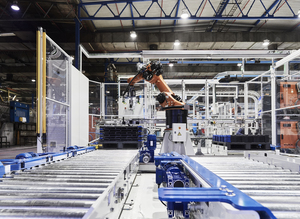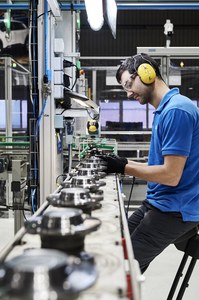

|
Edward Lowton
Editor |


|
| Home> | Energy Management | >Sustainable energy | >Factory setting: the road to Net Zero |
Factory setting: the road to Net Zero
30 November 2022
Achieving Net Zero manufacturing operations by 2030 – and a Net Zero supply chain by 2050 – will need major changes in efficiency, raw material and energy sourcing says Rob Jenkinson

IT'S AN issue which, on the face of it, appears extremely challenging to solve: how can energy and raw material-hungry manufacturing companies cut their carbon emissions to zero?
At SKF, we’ve been addressing this for the last 20 years. Our global emissions, including those from our own operations, all upstream supply chain and downstream logistics are currently around 1.8 million tonnes/year of carbon dioxide equivalent. That’s still a lot of carbon – but it’s far lower than it was in 2001.
Our emissions come from a range of sources – primarily our direct energy use, and the embodied carbon in the steel we use and the impact of transportation of raw materials and finished products. We have two clear goals: for all our factories to be Net Zero by 2030; and for our entire supply chain to be Net Zero by 2050. We don’t consider either of these an impossibility – and nor should other manufacturers.
So how can a relatively energy-intensive company like ours reach such targets? There are no silver bullets but by developing and deploying a range of measures, we think it's possible. This ranges from conventional energy-efficiency measures, and waste avoidance, to electrification and sourcing renewable energy; Optimising transports through to the use of emerging technology such as green steel production.
Material gains
One of the most challenging sustainability problems for many manufacturing companies is likely to be driving the decarbonisation of the raw materials from which the products are made. For SKF, steel forms the basis of most of our products. Historically – when we purchased steel we were concerned with the price and availability along with its technical features and quality. Now we must add the embodied carbon (the amount of CO2 it takes to produce a ton of steel) to that list.
While we don’t have direct control over this, that doesn’t mean we have no control at all. We want to support the steel industry in its decarbonisation journey. That’s why we’re a member of Steel Zero – a group of steel users that want the steelmaking process to be decarbonised and who advocate collectively for this change. Members have publicly committed to procure 100% net-zero steel by 2050.
One of the most promising technology routes to achieve the decarbonisation of ore-based production of steel is to use hydrogen based direct reduction. The hydrogen replaces fossil fuels used in conventional reduction processes, and if 'Green Hydrogen' is used (hydrogen produced using renewable energy) then it's possible to almost eliminate the carbon emissions that would have occurred with the conventional method.
SKF is part of a consortium of Nordic businesses and organisations working towards this goal. As part of Luleå University of Technology’s CH2ESS initiative, we will participate in – and fund – research into using hydrogen in industrial processes and energy systems. This should speed up the development of fossil-free bearing steel.
Factory output
One place where manufacturers do have direct control over carbon emissions is in their own factories. SKF first reported its own emissions in 2001 – and we’ve steadily reduced them ever since. There are two main elements in our strategy here, efficiency and switching to renewable energy sources.
We drive energy efficiency in our factories around the world by applying the ISO 50001 energy management standard and by setting and following up aggressive improvement targets. We’ve been successful. We use less energy per year now, than we did in 2006, but in that same period the business has grown by around 60%.
It’s not just energy efficiency, we also drive material efficiency and, through our application of lean manufacturing, work to eliminate all types of waste in our operations. Almost always when you take out waste, you reduce carbon emissions.
But we can never get to Net Zero on energy efficiency alone, we must switch energy sources away from fossil-based high carbon to renewable energy. Electricity accounts for 75% of our total energy use: in 2021, about 50% of this was renewable. To move closer to Net Zero, we need to keep increasing our use of renewable energy.
One way we do this is through power purchase agreements. These work by promising to buy a certain amount of electricity from a proposed wind turbine installation, for instance. Committing in advance – for a period of 10-15 years – provides the project investor with a secure revenue which helps make the business case for the wind farm or whatever it is. In exchange for that we secure a source of renewable electricity, at a fixed or discounted price – while avoiding price fluctuations.
Another challenge is to find alternatives to the fossil fuels used directly in our operations – for SKF this is mainly natural gas used for building and process heating. SKF’s plant in Tudela, Spain became carbon neutral by 2021 – without using any carbon offsetting. Reaching Net Zero meant finding an alternative to the natural gas that was used to heat the building – which generated around 600 tonnes/year of CO2 every year. This was achieved using an electrically driven heat pump, which is used for heating in winter and cooling in summer.
Delivery targets
Decarbonising our logistics operations will also help us to meet our 2050 target for a Net Zero supply chain. One key concern is the way that products are shipped. Rail and sea are the most sustainable – while air is the least. In fact, while air freight accounts for around 1% of our logistics volume, it contributes around half the related emissions.
Nobody wants to deliver products by air. While there will probably always be emergency situations where air freight can’t be avoided, driving improved communication and planning up and down the value chain can keep this to an absolute minimum.
Another important factor in logistics is regionalisation. The days of making products centrally – and shipping them all around the world – are disappearing. Instead, we are quickly moving towards a more localised approach.
There are exciting new technology options also coming on stream – such as fully electric and autonomous trucks which SKF is already using to transport from our factory to our warehouse in Gothenburg, Sweden.
By 2030, we expect to have cut more than one-third of our emissions from logistics, compared to 2019.
Business imperative
Climate change is a challenge unlike any other that we've faced in the business world. However, it is important to remember that business needs to continue, in spite of it.
Many of our customers are as committed to Net Zero as we are – and are prepared to pay a premium for sustainable products. They routinely ask details such as how much embodied carbon is in our bearings and use this – alongside price, and other factors – in their decision-making process.
Our products are relatively low in embodied carbon – and we are winning business off the back of it. This shows that sustainable manufacturing is now part of the mainstream, with distinct business advantages. Manufacturers that can understand this – and apply to their own operations – are in the best position to reap the benefits.
Rob Jenkinson is director of sustainability at SKF
For more information:
Tel: 01275 876021
- Lubrication monitor
- Simplified machine health monitoring from SKF
- Grease gun with lithium ion battery
- Vibration assessment
- Efficient lubrication strategy?
- Beware improper installation inssues
- Hybrid bearings: Coping with extremes
- Mobile app and vibration sensor
- Food industry compliant bearings
- New European aeronautical test centre
